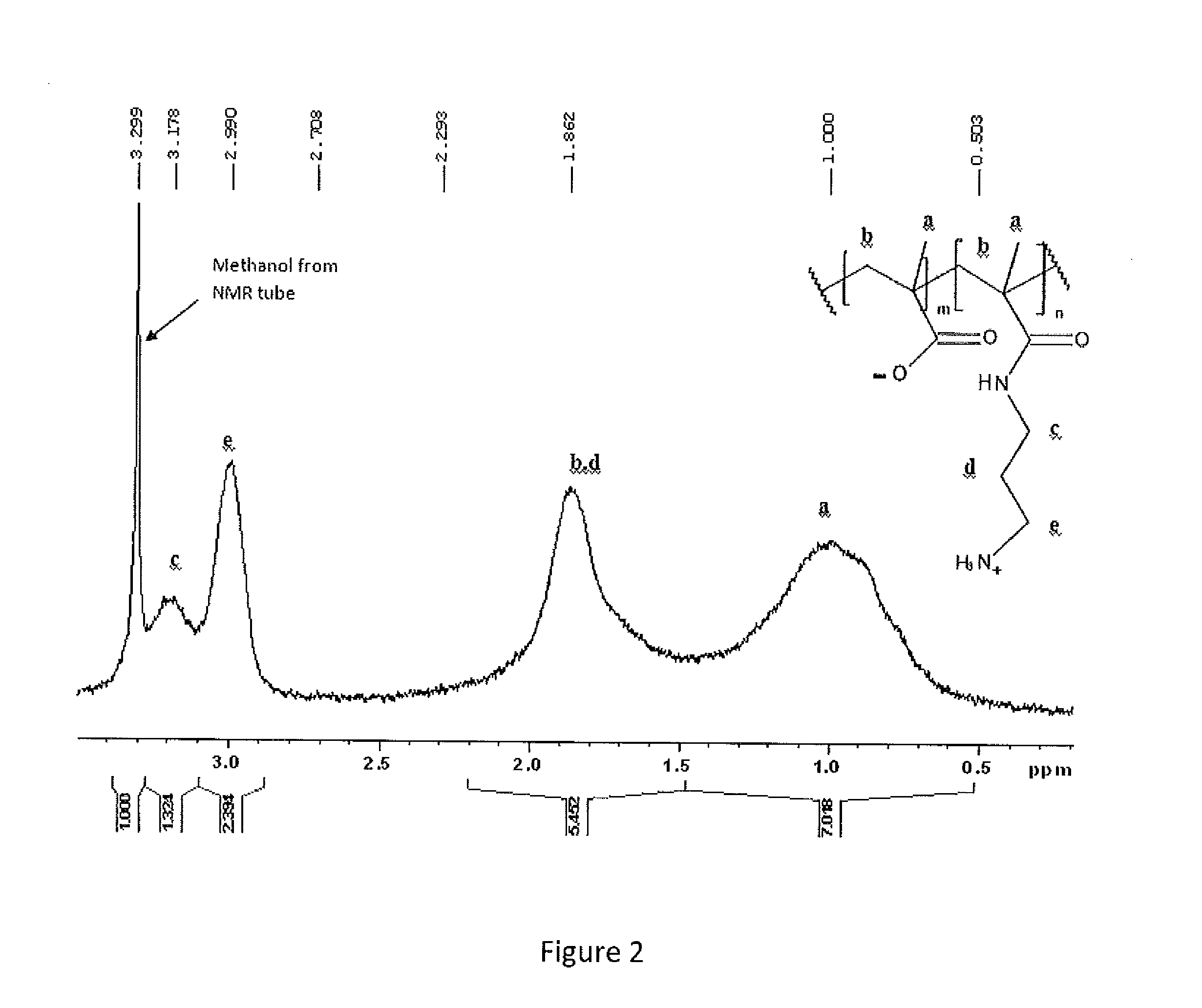Immunocompatible polymers
a polymer and immunocompatibility technology, applied in the direction of microcapsules, capsule delivery, pharmaceutical non-active ingredients, etc., can solve the problems of high charge density polycations near the capsule surface, many challenges in strength and biocompatibility of capsules, and cytotoxic high charge density polycations,
- Summary
- Abstract
- Description
- Claims
- Application Information
AI Technical Summary
Benefits of technology
Problems solved by technology
Method used
Image
Examples
example 1
Methods and Materials
[0064]N-(3-aminopropyl)methacrylamide hydrochloride (APM) from Polysciences and methacrylic acid (MAA, 99%), sodium methacrylate (NaMAA), N-(2-hydroxyethyl)acrylamide), ethylene carbonate (98%), 2,2′-azobis(2-methylpropionamidine) dihydrochloride (Vazo-56) and fluorescein isothiocyanate isomer 1 (FITC) from Sigma-Aldrich were used as received. N,N-Dimethylformamide (DMF, reagent grade) and methanol (reagent grade) were obtained from Caledon Laboratories (Caledon, ON). Methanol-d4 and deuterium oxide (D2O) were purchased from Cambridge Isotope Laboratories (Andover, Mass.). Sodium hydroxide and hydrochloric acid solutions (0.10 and 1.0 M) were obtained from LabChem Inc. Sodium alginate (Pronova UP MVG; 70% G) was purchased from NovaMatrix (Sandvika, Norway). Poly(methacrylic acid-co-4,4-dimethyl-2-vinyl-2-oxazoline-5-one) [50:50] (PMV50) was prepared as described in Gardner and Stöver, Macromolecules 2011, 44, 7115-7123.
Optimization of APM-MAA Copolymerization
[00...
example 2
Ternary Polyampholytes
[0106]Ternary copolymers of 3-aminopropylmethacrylamide (APM), methacrylic acid (MM) and 2-hydroxyethylacrylamide (HEA) were prepared by free radical copolymerization in water at 10 weight % total monomer loading using a cationic azo initiator. The ratio of APM and MAA was kept equimolar, while the nominal mol % HEA in the copolymerizations was varied from 14.3%, 20%, 25%, 33%.
[0107]Compositional drift between APM and MAA during these ternary copolymerizations was minimized by replacing portions of the MAA with the corresponding sodium salt (sodium methacrylate, NaMAA), in order to obtain equimolar incorporation of these two monomer types (APM, and MAA+NaMAA) during the copolymerization. This is illustrated in FIG. 9, which shows the ratio of APM:(MAA+NaMAA) in the monomer pool during copolymerizations of APM, MAA, HEA in an overall 33.3:33.3:33.3% ratio, but with MAA:NaMAA ratios ranging from 50:0, 10:40, 12.5:37.5, 25:25, 16.67:33.33, 0:50.
[0108]The mol fract...
example 3
APM / AA Polyampholytes
[0112]Binary copolymers of 3-aminopropylmethacrylamide (APM) and acrylic acid (AA) formed by free radical copolymerization in water as previously described and were found to have higher polarity compared to the corresponding APM / MAA copolymers. As a result, the 1:1 (molar ratio) APM:AA copolymer has solubility behaviour comparable to some of the ternary APM / MAA / HEA copolymers, as seen in FIG. 15 which shows the titration of aqueous solutions of poly(APM-co-AA) 50:50 at different salt levels by addition of either acid (from high to low pH) or base (from low to high pH). In absence of salt, the copolymer shows a pronounced region of insolubility about its IEP (black line), while at 150 mM sodium chloride (purple line), the copolymer is marginally soluble, with some turbidity. When a solution of the copolymer at pH 7.5 is heated, phase separation occurs with the phase separation temperature increasing as more salt is added. Phase separation creates a concentrated p...
PUM
| Property | Measurement | Unit |
|---|---|---|
| transmittance | aaaaa | aaaaa |
| transmittance | aaaaa | aaaaa |
| transmittance | aaaaa | aaaaa |
Abstract
Description
Claims
Application Information
 Login to View More
Login to View More - R&D
- Intellectual Property
- Life Sciences
- Materials
- Tech Scout
- Unparalleled Data Quality
- Higher Quality Content
- 60% Fewer Hallucinations
Browse by: Latest US Patents, China's latest patents, Technical Efficacy Thesaurus, Application Domain, Technology Topic, Popular Technical Reports.
© 2025 PatSnap. All rights reserved.Legal|Privacy policy|Modern Slavery Act Transparency Statement|Sitemap|About US| Contact US: help@patsnap.com



